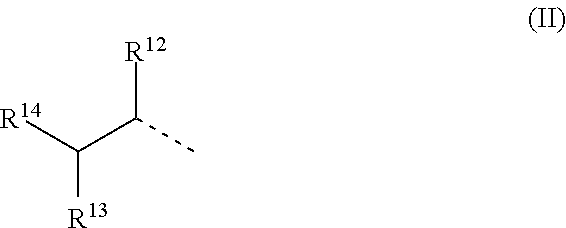Silane-terminated adhesive for joining joints in the naval field
a technology of silanetermination and adhesive, which is applied in the direction of polyether adhesives, other domestic articles, adhesive types, etc., can solve the problems of poor workability, cracking, and cracking of commercial aliphatic polyurethane products, and achieve high uv stability and stability, good workability, and high yellowing stability
- Summary
- Abstract
- Description
- Claims
- Application Information
AI Technical Summary
Benefits of technology
Problems solved by technology
Method used
Image
Examples
example 1
Preparation of the Silane-Functional Polymer P
[0128]Under a nitrogen atmosphere, 700 g of Acclaim® 12200 polyol (Bayer MaterialScience AG, Germany; low monol polyoxypropylenediol; OH number 11.0 mg KOH / g; water content about 0.02 wt %), 32.1 g of isophorone diisocyanate (Vestanat® IPDI, Evonik Degussa GmbH, Germany), 85.4 g of 2,2,4-trimethyl-1,3-pentanediol diisobutyrate (Eastman TXIB™; Eastman Chemical Company, USA), and 0.4 g of Tyzor® IBAY (from DuPont, USA) were heated to 90° C. with continuous stirring, and left at this temperature. After a reaction time of an hour, the free isocyanate group content attained, by titration, was 0.7 wt %. Subsequently 0.14 mol (corresponding to a stoichiometric reaction of the NCO groups with silane) of reactive silane (Int-EtO) was added, and stirring was continued at 90° C. for a further 2 to 3 hours. The reaction was terminated when free isocyanate was no longer detectable by IR spectroscopy (2275-2230 cm−1). The product was cooled to room te...
example 2
[0137]The production of the adhesive as in example 1 was repeated, except that 3 parts by weight of gray pigment were used rather than 3 parts by weight of titanium dioxide. In this way a gray adhesive was obtained. The tests from example 1 were repeated. The results obtained were as follows:
[0138]Viscosity (23° C.): 300 Pas
[0139]Flow in the U-profile: 0.3 cm
[0140]Delta E after 3000 h in the Suntester or QUV tester: 1.8
[0141]No cracking in the sanded joint after 3000 h in the Suntester or QUV tester
example 3
[0142]The production of the adhesive as in example 1 was repeated, except that 3 parts by weight of carbon black were used rather than 3 parts by weight of titanium dioxide. In this way a black adhesive was obtained. The tests from example 1 were repeated, but delta E was not determined, since it is irrelevant for black materials. The results obtained were as follows:
[0143]Viscosity (23° C.): 400 Pas
[0144]Flow in the U-profile: 0.1 cm
[0145]No cracking in the sanded joint after 3000 h in the Suntester or QUV tester
PUM
| Property | Measurement | Unit |
|---|---|---|
| temperature | aaaaa | aaaaa |
| shrinkage | aaaaa | aaaaa |
| temperatures | aaaaa | aaaaa |
Abstract
Description
Claims
Application Information
 Login to View More
Login to View More - R&D
- Intellectual Property
- Life Sciences
- Materials
- Tech Scout
- Unparalleled Data Quality
- Higher Quality Content
- 60% Fewer Hallucinations
Browse by: Latest US Patents, China's latest patents, Technical Efficacy Thesaurus, Application Domain, Technology Topic, Popular Technical Reports.
© 2025 PatSnap. All rights reserved.Legal|Privacy policy|Modern Slavery Act Transparency Statement|Sitemap|About US| Contact US: help@patsnap.com



